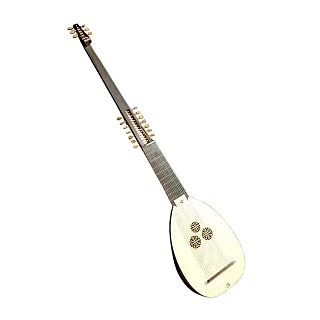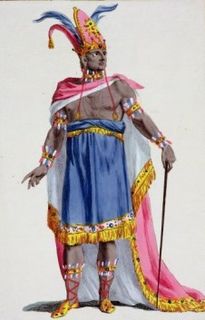
Figured bass, also called thoroughbass, is a kind of musical notation in which numerals and symbols indicate intervals, chords, and non-chord tones that a musician playing piano, harpsichord, organ, lute play in relation to the bass note that these numbers and symbols appear above or below. Figured bass is closely associated with basso continuo, a historically improvised accompaniment used in almost all genres of music in the Baroque period of Classical music (c.1600–1750), though rarely in modern music.

A lute is any plucked string instrument with a neck and a deep round back enclosing a hollow cavity, usually with a sound hole or opening in the body. More specifically, the term "lute" can refer to an instrument from the family of European lutes. The term also refers generally to any string instrument having the strings running in a plane parallel to the sound table. The strings are attached to pegs or posts at the end of the neck, which have some type of turning mechanism to enable the player to tighten the tension on the string or loosen the tension before playing, so that each string is tuned to a specific pitch. The lute is plucked or strummed with one hand while the other hand "frets" the strings on the neck's fingerboard. By pressing the strings on different places of the fingerboard, the player can shorten or lengthen the part of the string that is vibrating, thus producing higher or lower pitches (notes).
In music, ornaments or embellishments are musical flourishes—typically, added notes—that are not essential to carry the overall line of the melody, but serve instead to decorate or "ornament" that line, provide added interest and variety, and give the performer the opportunity to add expressiveness to a song or piece. Many ornaments are performed as "fast notes" around a central, main note.
Sheet music is a handwritten or printed form of musical notation that uses musical symbols to indicate the pitches, rhythms or chords of a song or instrumental musical piece. Like its analogs – printed books or pamphlets in English, Arabic or other languages – the medium of sheet music typically is paper, although the access to musical notation since the 1980s has included the presentation of musical notation on computer screens and the development of scorewriter computer programs that can notate a song or piece electronically, and, in some cases, "play back" the notated music using a synthesizer or virtual instruments.
Rondo and the part-equivalent French term, rondeau, are words long used in music in a number of ways, most often in reference to a musical form.
In music, the dynamics of a piece is the variation in loudness between notes or phrases. Dynamics are indicated by specific musical notation, often in some detail. However, dynamics markings still require interpretation by the performer depending on the musical context: for instance a piano (quiet) marking in one part of a piece might have quite different objective loudness in another piece, or even a different section of the same piece. The execution of dynamics also extends beyond loudness to include changes in timbre and sometimes tempo rubato.

The theorbo is a plucked string instrument of the lute family, with an extended neck and a second pegbox. Like a lute, a theorbo has a curved-back sound box with a wooden top, typically with a sound hole, and a neck extending out from the soundbox. As with the lute, the player plucks or strums the strings with one hand while "fretting" the strings with the other hand; pressing the strings in different places on the neck produces different pitches (notes), thus enabling the performer to play chords, basslines and melodies.

Reverend Gary Davis, also Blind Gary Davis, was a blues and gospel singer who was also proficient on the banjo, guitar and harmonica. His fingerpicking guitar style influenced many other artists. His students include Stefan Grossman, David Bromberg, Steve Katz, Roy Book Binder, Larry Johnson, Nick Katzman, Dave Van Ronk, Rory Block, Ernie Hawkins, Larry Campbell, Bob Weir, Woody Mann, and Tom Winslow. He influenced Bob Dylan, the Grateful Dead, Wizz Jones, Jorma Kaukonen, Keb' Mo', Ollabelle, Resurrection Band, and John Sebastian.

Motezuma, RV 723, is an opera in three acts by Antonio Vivaldi with an Italian libretto by Alvise Giusti. The libretto is very loosely based on the life of the Aztec ruler Montezuma who died in 1520. The first performance was given in the Teatro Sant'Angelo in Venice on 14 November 1733. The music was thought to have been lost, but was discovered in 2002 in the archive of the music library of the Sing-Akademie zu Berlin. Its first fully staged performance in modern times took place in Düsseldorf, Germany, on 21 September 2005.
In music, instrumentation is the particular combination of musical instruments employed in a composition, and the properties of those instruments individually. Instrumentation is sometimes used as a synonym for orchestration. This juxtaposition of the two terms was first made in 1843 by Hector Berlioz in his Grand traité d'instrumentation et d'orchestration modernes, and various attempts have since been made to differentiate them. Instrumentation is a more general term referring to an orchestrator's, composer's or arranger's selection of instruments in varying combinations, or even a choice made by the performers for a particular performance, as opposed to the narrower sense of orchestration, which is the act of scoring for orchestra a work originally written for a solo instrument or smaller group of instruments.

Portrait of a Musician is an unfinished portrait painting attributed to Italian Renaissance polymath Leonardo da Vinci, dated c. 1483–1487. Painted in oil on walnut panel, it is Leonardo's only known male portrait, whose identity is unknown, and has been closely debated among scholars. Until the 20th century it was thought to depict Ludovico Sforza, a Duke of Milan and employer of Leonardo. During a 1904–1905 restoration, the removal of overpainting revealed a hand holding sheet music, suggesting the sitter to be a musician.

Francesco Corbetta was an Italian guitar virtuoso, teacher and composer. Along with his compatriots Giovanni Paolo Foscarini and Angelo Michele Bartolotti, He was a pioneer and exponent of the combination of strummed and plucked textures referred to today as "mixed" style.

Musical improvisation is the creative activity of immediate musical composition, which combines performance with communication of emotions and instrumental technique as well as spontaneous response to other musicians. Sometimes musical ideas in improvisation are spontaneous, but may be based on chord changes in classical music and many other kinds of music. One definition is a "performance given extempore without planning or preparation." Another definition is to "play or sing (music) extemporaneously, by inventing variations on a melody or creating new melodies, rhythms and harmonies." Encyclopædia Britannica defines it as "the extemporaneous composition or free performance of a musical passage, usually in a manner conforming to certain stylistic norms but unfettered by the prescriptive features of a specific musical text. Improvisation is often done within a pre-existing harmonic framework or chord progression. Improvisation is a major part of some types of 20th-century music, such as blues, rock music, jazz, and jazz fusion, in which instrumental performers improvise solos, melody lines and accompaniment parts.

The Baroque guitar is a string instrument with five courses of gut strings and moveable gut frets. The first course sometimes used only a single string.

Classical music is art music produced or rooted in the traditions of Western culture, including both liturgical (religious) and secular music. While a more precise term is also used to refer to the period from 1750 to 1820, this article is about the broad span of time from before the 6th century AD to the present day, which includes the Classical period and various other periods. The central norms of this tradition became codified between 1550 and 1900, which is known as the common-practice period.

Baroque music is a period or style of Western art music composed from approximately 1600 to 1750. This era followed the Renaissance music era, and was followed in turn by the Classical era, with the galant style marking the transition between Baroque and Classical eras. The Baroque period is divided into three major phases: early, middle, and late. Overlapping in time, they are conventionally dated from 1580 to 1650, from 1630 to 1700, and from 1680 to 1750. Baroque music forms a major portion of the "classical music" canon, and is now widely studied, performed, and listened to. The term "baroque" comes from the Portuguese word barroco, meaning "misshapen pearl". Key composers of the Baroque era include Johann Sebastian Bach, Antonio Vivaldi, George Frideric Handel, Claudio Monteverdi, Domenico Scarlatti, Alessandro Scarlatti, Henry Purcell, Georg Philipp Telemann, Jean-Baptiste Lully, Jean-Philippe Rameau, Marc-Antoine Charpentier, Arcangelo Corelli, François Couperin, Giuseppe Tartini, Heinrich Schütz, Dieterich Buxtehude, and others.
Giovanni Paolo Foscarini was an Italian guitarist, lutenist, theorist and composer.
Edith Borroff was an American musicologist and composer. Her compositions, including over 60 commissioned works, include pieces for the stage, for her primary instrument—the organ, choral, vocal, and orchestral music, and several critical editions of works by previous composers such as Jubilate by J.-J. Cassanéa de Mondonville. She also wrote at least 7 books, including the textbook Music in Europe and the United States: a History, as well as various peer-reviewed articles and publications.
To a greater extent than most other instruments and ensembles, it is difficult to compose music for the guitar without either proficiency in the instrument or close collaboration with a guitarist. As a result, a large part of the guitar repertoire consists of works by guitarists who did not compose extensively for other instruments. Music prior to the classical era was often composed for performance on various combinations of instruments, and could be adapted by the performer to keyboard instruments, the lute, or the guitar. Since the beginning of the 20th century, however, a significant amount of music has been written for the guitar by non-guitarist composers.
Stefano Pesori was a 17th-century Italian 5-course Baroque guitarist, composer, and teacher.










